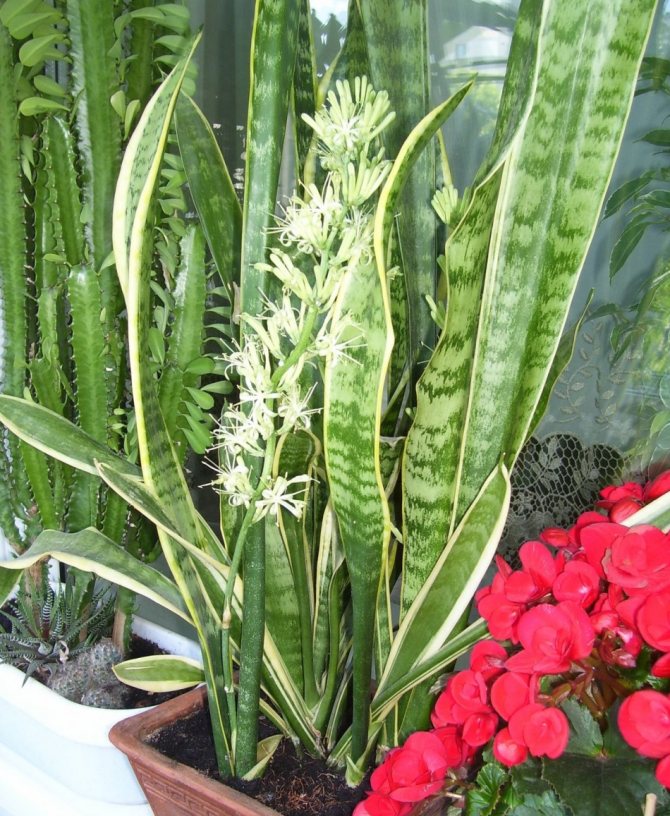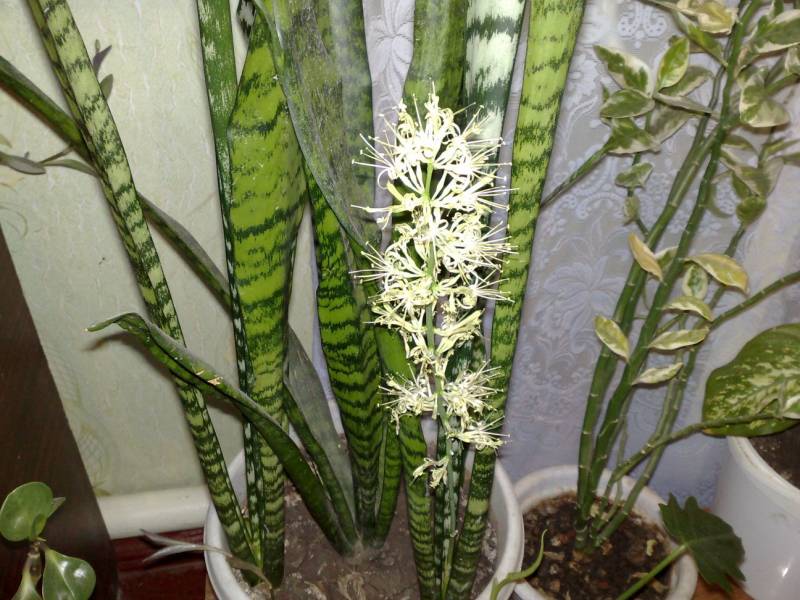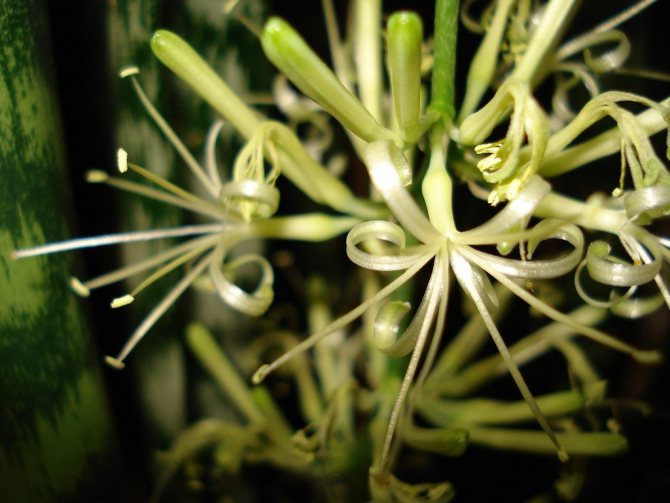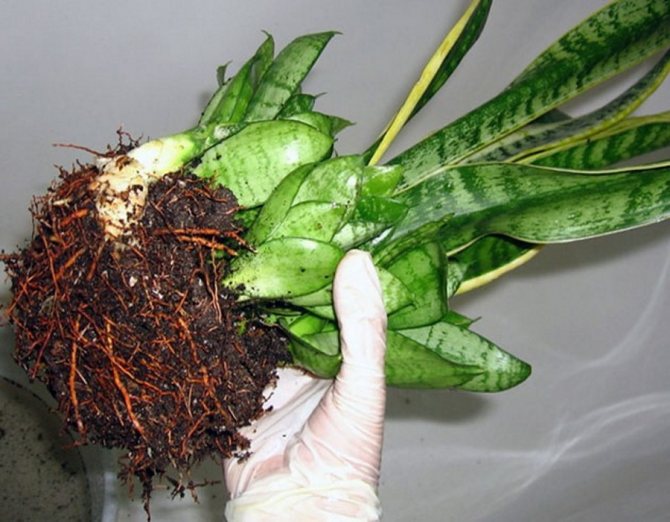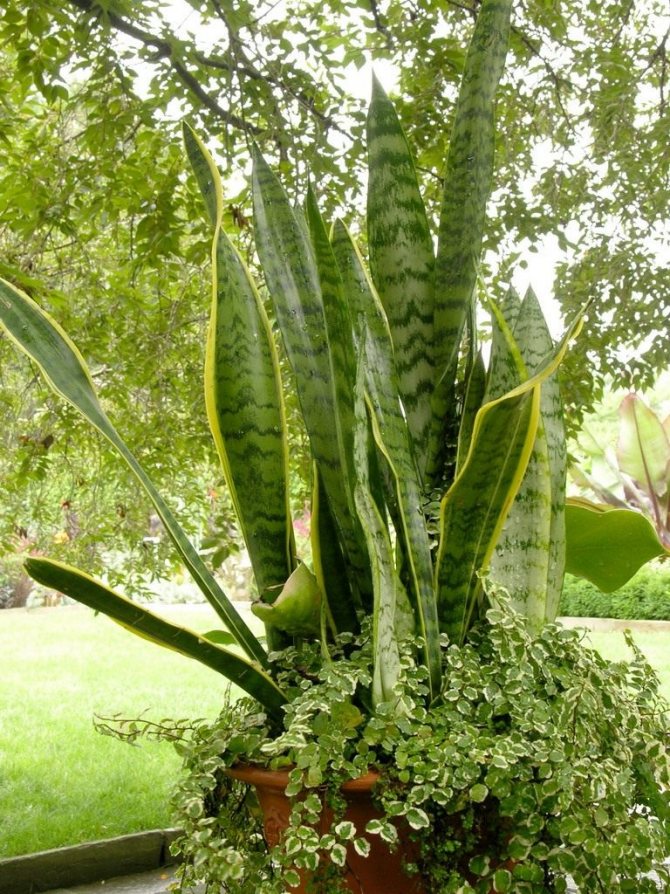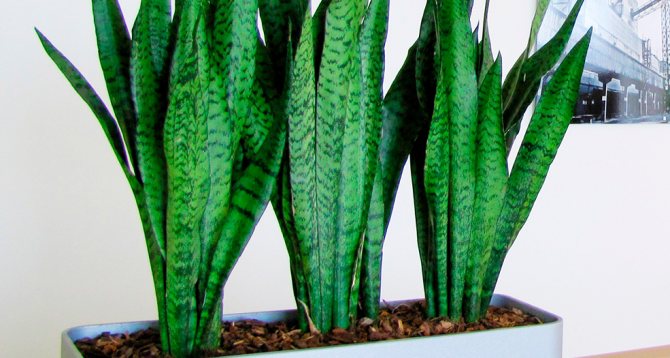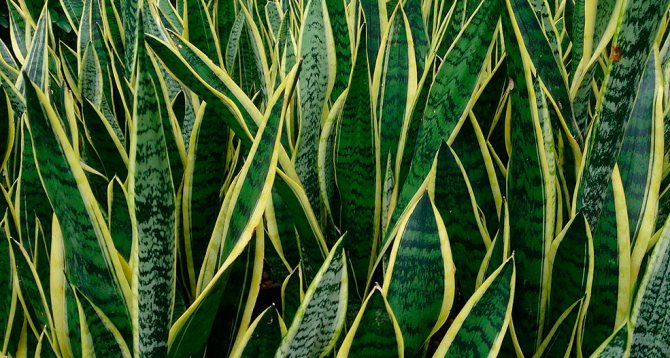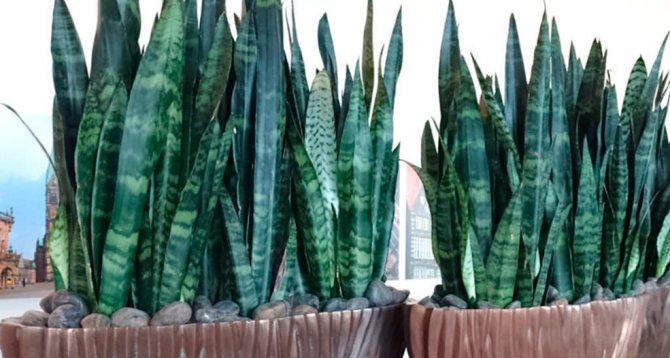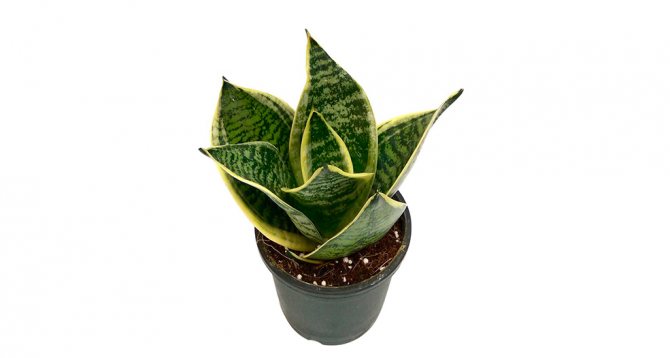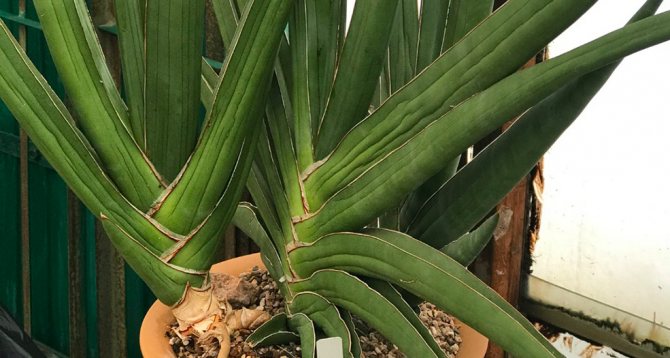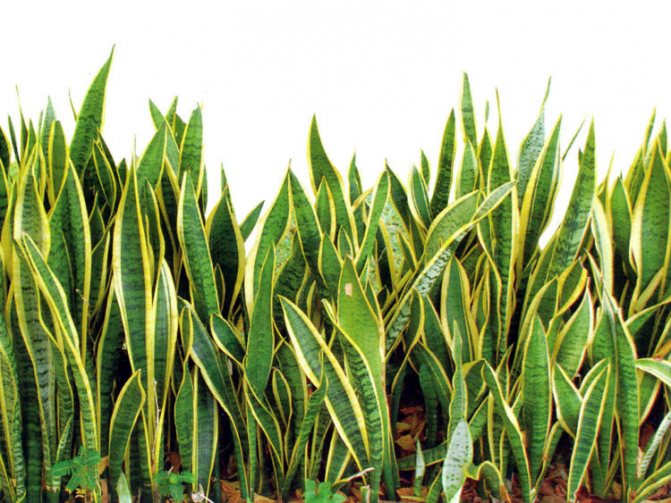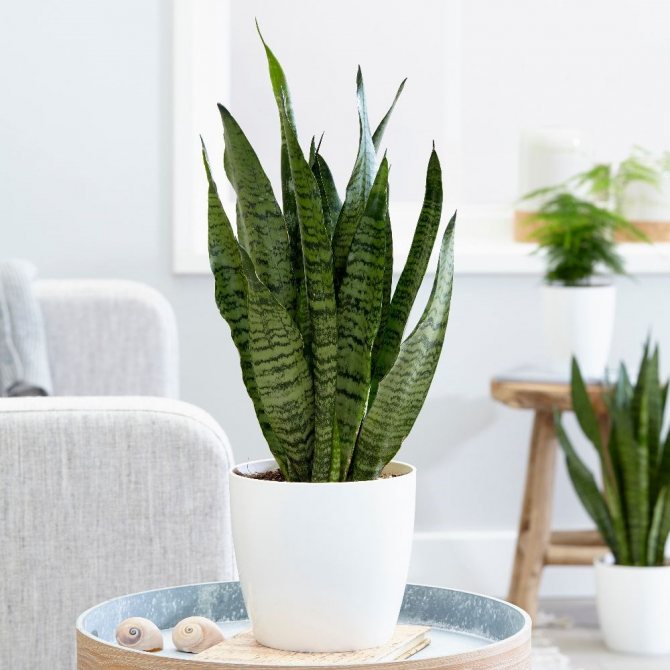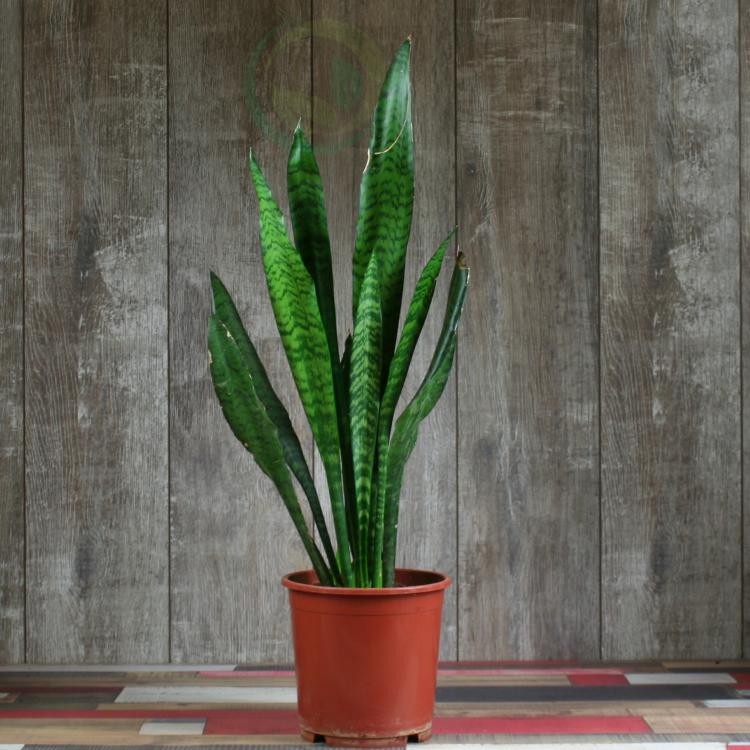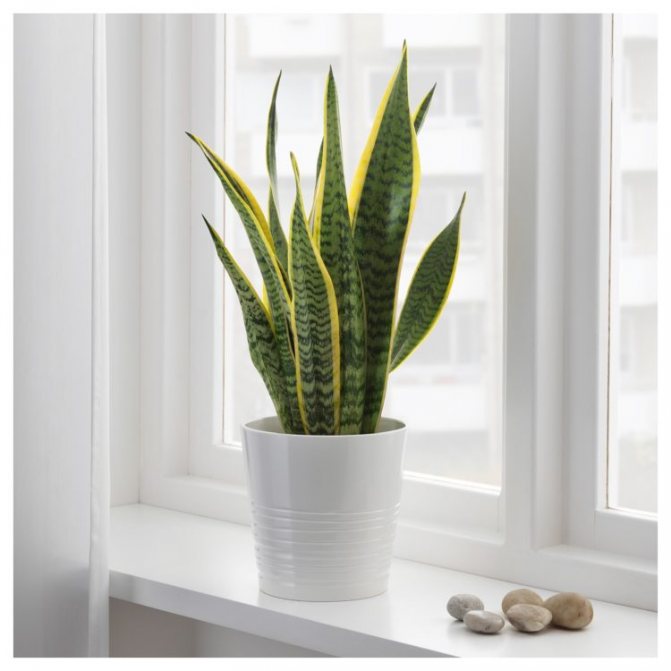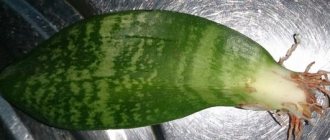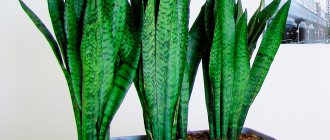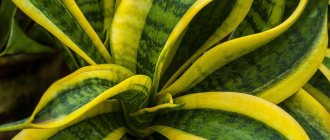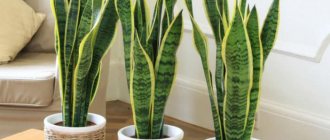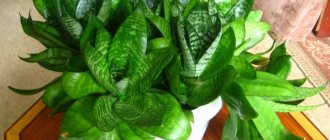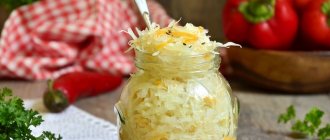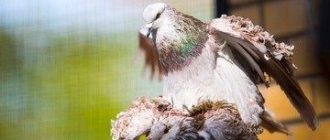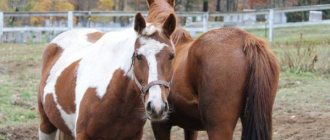Domestic species
In the genus Sansevieria, there are more than six dozen species of perennials. Evergreen, without the formation of stems, succulent has excellent qualities for indoor cultivation: unpretentious care and emphasized decorativeness. A large selection of shapes and colors allows you to find a plant to your liking.
Guinean - Three-lane (Sansevieria trifasciata)
Widespread variety. The length of the sheet plates is one and a half meters with a width of ten centimeters. Fleshy, with a dense structure, the leaves are painted in dark green tones with transverse light stripes. The color is complemented by a bright marginal border of yellowish shades. He is the founder of many varieties.
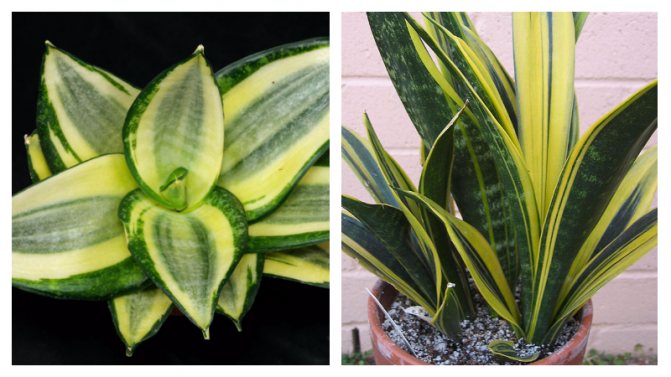
Sansevieria Guinea - Three-lane
Moonshine (Sansevieria trifasciata ‘Moonshine’)
Fascinates with colors. The basis of the leaf surface is presented in a light gray with a greenish tone. There is also a silver version. Under close gaze, stripes appear across the sheet, blurred outlines.
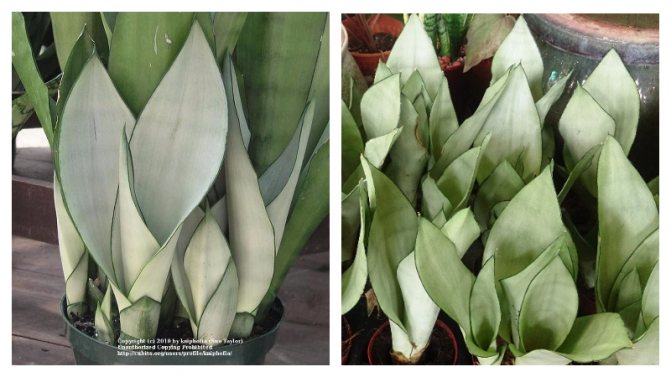

Sansevieria Munshine
Hanni (Sansevieria trifasciata ‘Hahnii’)
The variety of the Guinean Sansevieria Hanni is characterized by expanded and shortened leaf shapes. Plant height up to three tens of centimeters.
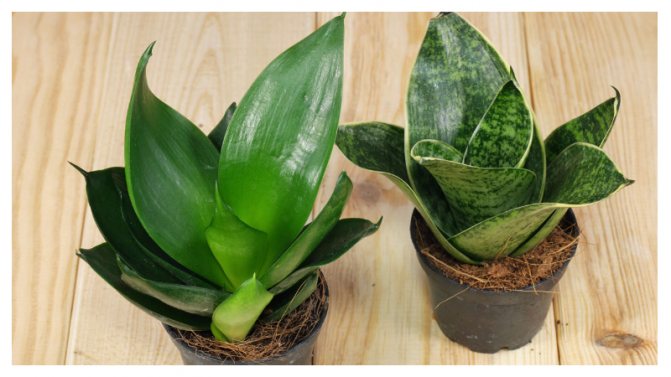

Sansevieria Hanni
Supplemented with color varieties:
- Golden Hanni (Sansevieria trifasciata ‘Golden hahnii’) - the inside of the leafy part is dark. The marginal border is wide, golden.
- Silver Hanni (Sansevieria trifasciata ‘Silver Hahnii’) - combined color from lines of white and grass tones.
- Laurenti (Sansevieria trifasciata var. Laurentii) Is a varietal specimen that has been in favor for several decades. The upward-pointing leafy arrows are framed by a large yellow-toned stripe. The spike flowers are located at the plant base.
- Sensation Bentle (Sansevieria trifasciata Sensation Bantel ') -sheets are distinguished by the alternation of stripes located along the length of the sheet. The color scheme is dark and white. Rare guest due to slow growth.
- Compact (Sansevieria trifasciata ‘Laurentii Compacta’) - a shortened and refined variety with uneven coloration of bright contrasts. It is characterized by slow growth. To preserve varietal characteristics, reproduction is possible only through the division of the rhizome.
- Nelson (Sansevieria trifasciata ‘Nelsonii’) Is another slow growing variety. It is interesting that the preservation of varietal qualities is transmitted only when the plant is propagated by the method of root division. Cutting leads to the growth of the original material.
- Silver Queen (Sansevieria trifasciata ‘Silver Queen’) - surprises with color. There are shades of light (bluish, greenish, silver) and dark (emerald) tones. Narrow leaf plate, tapered towards the end. A common variety.
- Twisted Sister (Sansevieria trifasciata Twisted Sister) —The rosette is formed by curving sheets, with a hint of twisting around itself. The yellow marginal stripe frames the colored ripples of light and dark shades of green running along the surface of the leaf plate. Pretty attractive.
- Craig (Sansevieria craigii) - no clear definition of the origin is indicated. An independent existence is possible. Leaf of a light yellow background, reaching a shade of whiteness. The striping is represented by greenery.
- Duneri (Sansevieria dooneri) - a distinctive feature of this succulent in the formation of multi-sheet rosettes (up to twenty narrow sheets). In growth it reaches 40 centimeters. Painted with a combination of a dark pattern on a light green background surface. The smell of white flowers on a long peduncle is similar to the scent of lilac.
Cylinder or Cylindrical (Sansevieria cylindrica)
Named for the outer outline of the sheet. A deep groove runs along its entire length, from the base to the dry tip. The half-meter peduncle ends with a carpal inflorescence of cream-colored flowers with the presence of a reddish bloom. Contrasts dramatically against the dark green foliage.
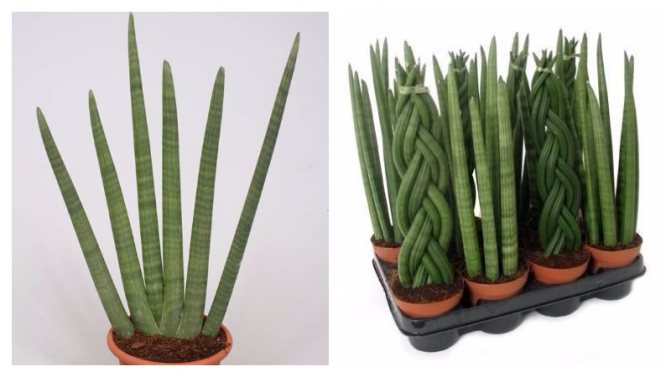

Sansevieria cylindrical
Futura (Sansevieria ‘Futura Superba’)
Low-growing plant. The average is below one third of a meter. Slightly curved leaf edges give the flower in an adult state a similarity in shape to a vase extended towards the top.
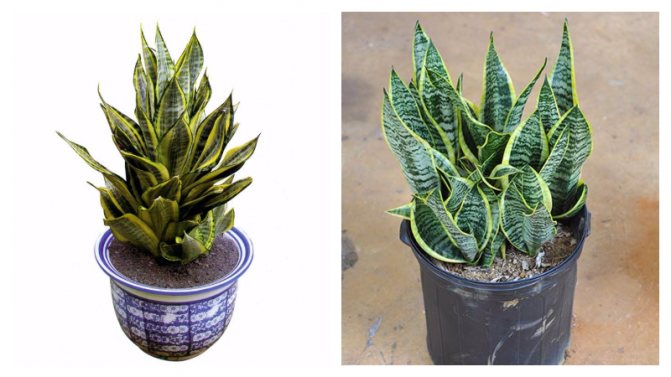

Sansevieria Futura
Robusta (Sansevieria ‘Robusta’)
This species has a very thin reddish border on the leaves. The base of the color is represented by a rich emerald color with darker ripples across. The leaves are short and wide, growing in a dense rosette.
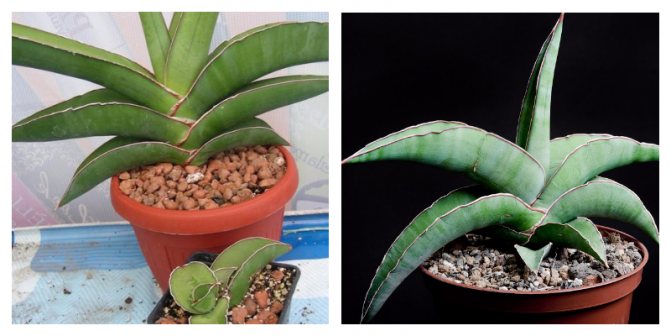

Sansevieria Robusta
Pickaxe (Sansevieria kirkii)
The unusual coloring of the plant gives the difference from others. There are color options for fallen leaves. There is also something simpler: the brown tint is present only in the edge stroke. Instead of striping, spots of light tones correspond to specific colors.
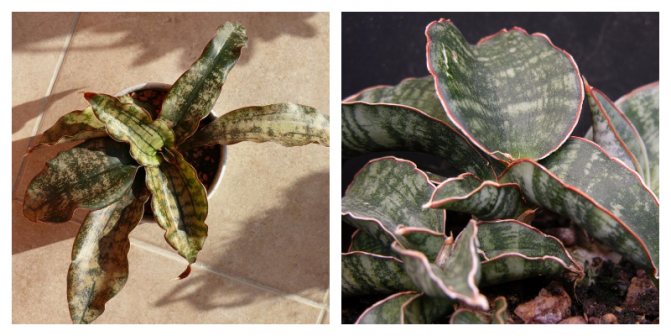

Sansevieria Kirka
Liberian (Sansevieria liberica)
The leaves are parallel to the ground. Usually half a meter long, but there are also "giants" (up to one meter). The green background is blurred with a light shade of streaks and streaks. Border of a reddish or brownish tone with a thin stripe.


Sansevieria Liberian
Graceful - graceful (Sansevieria gracilis)
A succulent plant with short leaves in the form of a pointed oval. At the base there is a short stem (about six centimeters), which gives “babies” for reproduction. On the green and gray surface, transverse beige stains are distributed.
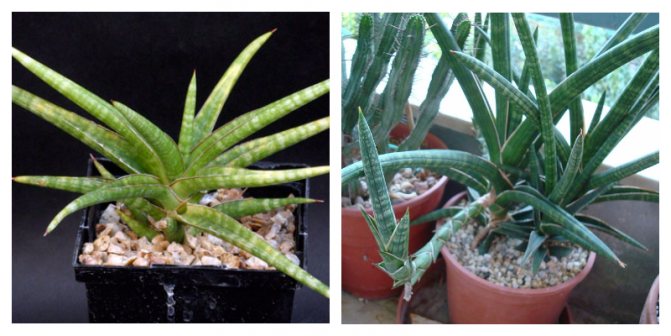

Sansevieria graceful
Hyacinth (Sansevieria hyacinthoides)
There are ampelous forms for growing in hanging structures. The hatching pattern follows the outline of the Latin letter "W". The peduncle "shoots" at 70 centimeters. The flowering period is in the winter, with small and aromatic springs.


Sansevieria Hyacinth
Big - grandis (Sansevieria grandis)
The most broad-leaved representative of Sansevieria (up to 15 centimeters in diameter). The length reaches a little over half a meter, which does not quite correspond to the name. Tall racemose inflorescences are densely covered with large white - green flowers.


Sansevieria grandis
Care
A wonderful indoor flower that does not require much effort in care and maintenance. Correctly and timely carried out simple watering operations, adherence to the temperature regime, the availability of sufficient lighting will help the plant to stay in the maximum possible color form. Maintain your individual decorativeness.
Watering
Succulents are characterized by the peculiarity of creating a water reserve inside the plant parts. This should be taken into account when regulating the amount and quality of soil moisture.
- Waterlogging leads to decay of the root system and, as a result, the death of the pet.
- The pike tail is able to do without water for a long time, but as a result it will respond with wilting.
- There are three main factors of prosperity interconnected: light, water, heat. Short daylight hours with a low temperature value slows down soil drying. A longer interval and a small amount of irrigation are optimal.
Lighting
Despite his love of light, he calmly tolerates partial shade and a shadow corner. The lack of light is reflected in the brightness and color scale of the color. It is manifested by the predominance of dark tones, the loss of contrasting light patterns and additions in the form of borders, stripes. At the same time, growth slows down and stops completely. The ideal condition is a location on the west or east side. Hit of the morning, evening rays of the sun.
During the light period of the day, the presence of bright scattered light. The winter period does not affect the mode of absorption of the light flux by the plant.The north side will require additional light sources. The southern windows, on the other hand, will have to be shaded on a summer day. The light time period lasts 16 hours for all species. You can leave everything as it is. Just don't expect too much from the plant.
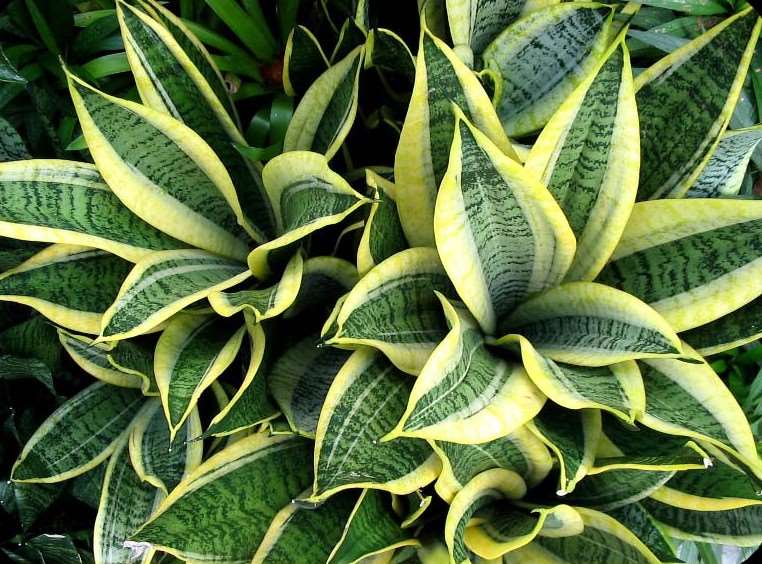

Temperature
There are upper and lower limits of the temperature range under which Sansevieria is able to exist. Seasonality is present, but does not play a big role. In the warm season, moderate parameters are located between 18 and 25 degrees Celsius.
Winter corrects the lower limit at 14 degrees above zero. Control is necessary to prevent hypothermia of the plant (ingress of strong fresh air during ventilation, contact with a frozen window). Prolonged exposure to cool temperatures provokes disease.
Humidity
The leaves of the flower are sprayed and spread with a damp soft cloth to remove dust and not to moisturize the leaf surface. It grows well both in dry indoor air and high humidity. In the second case, another adjustment is required on the part of irrigation.
Fertilizer
Fertilization is a very neat process when applied to succulent specimens. An overabundance is more problematic than a deficiency. This is rotting, and the loss of variegated colors, and deformation of the sheet plates. Shady and cool content does not require feeding. In spring and summer, it is permissible to use fertilizers for cacti with a low nitrogen content. Once a month at half dosage.


The soil
A prepared mixture of two parts of sod land is used with the addition of half components of leafy earth, peat and sand. It is possible to use ready-made soil for geraniums, adding one third of the sand from the volume of the substrate (to improve drainage properties). Hydroponics is suitable.
Transfer
The need for a plant transplant arises as the root system grows. Juveniles move two years later. Adults are transplanted after three. The new capacity is taken a little more than the previous one. The plant should not be spacious. Affects the flowering of an individual.
Read the article - photo instructions for transplanting sansevieria
Useful video
How to transplant a flower
Bouvardia flower: home care and propagation methods
The number of transplants depends on the age of the plant. A young mother-in-law's tongue is transplanted every spring. For older flowers, once every 2-3 years is enough. The transplant container should not be much larger than the previous one, as the roots grow slowly.
Important! A transplant is necessary when the roots completely encircle the ground.
When transplanting, the overgrown rhizome is cut and planted in suitable containers, having previously treated the cuts with charcoal.
A correctly transplanted mother-in-law's tongue develops and blooms well.
In good conditions, the rhizomes grow with young shoots. They need to be seated. If the shoot has at least one growth bud, it may well grow on its own in a separate container.
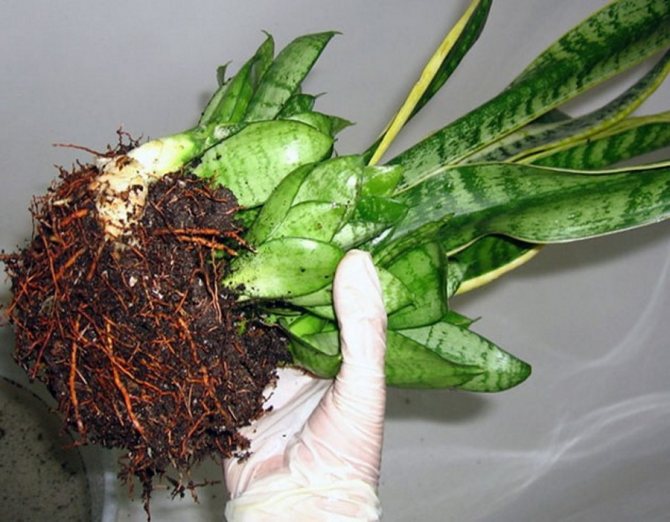

Transfer
Reproduction
There are two ways to get new wards - dividing the rhizome and leaf cuttings. Some varieties, due to their specificity, retain individual characteristics only with root division. The resulting plants from the leaf in these cases are obtained from the original (parental) species. Reproduction in this way is done in the spring.
Root division
At the root, parts containing a leaf rosette and a growing point are determined. The targeted sectors are divided with a sharpened knife, leaving earth on each piece. From a well-developed, powerful rhizome, you can get several parts of the planting material. The first soil is a sandy soil mixture.
It is allowed to place plantings in separate vessels, or in a common wide bowl. Pre-cut sites are processed with charcoal. Watering should be done with caution, in small portions, and not often. Having grown fresh roots, fresh rosettes appear at each "cutter". Neoplasms are moved to individual containers. As it grows, transplantation is carried out in pots of the desired parameters.
Sheet
- A healthy adult leaf is taken. On the lower surface, it is divided into five centimeter segments, across. Finished parts remain in a shady place, preferably with low humidity, until slightly dried. The landing container is filled.
- You need a wide container with one wet sand, or with an admixture of peat. It is rammed to a fairly dense state, with an indent from the upper edge of 1 centimeter. In the small grooves, the planting material is placed with the lower cut edge, previously processed by Kornevin.
- The cuttings are deepened by 10, 20 millimeters in a vertical position. Greenhouse conditions can cause rotting. In this regard, the sprouts are placed in a warm, bright place of moderate humidity. It is advisable to avoid direct rays of the sun, so as not to cause sunburn on the leaf surface.
- The temperature regime is maintained at a level of at least two tens of degrees for a couple of months. At this point, young shoots begin to appear from the planted sectors. Sprouted cuttings are transplanted according to the principle of young growth during root division.
Another very simple method of foliar propagation. A strong, good leaf is placed in a jar of water until root ends appear. Then it is planted in the main pot with the final soil.


Sansevier recipes
Ulcers and wounds
- Ingredients: fresh sansevier leaf.
Cut off the old leaf, rinse in boiled water, drain, chop and squeeze the juice. Moisten a gauze napkin in juice, apply to the affected area, secure with a bandage. Change the bandage 2 times a day.
Itchy skin
- Ingredients: 2 tbsp. tablespoons of sansevier leaf, 250 ml of water.
Grind the dry leaf of the sansevier, pour boiling water, cook in a water bath for 10 minutes, leave until cooled. Wash the affected areas with broth and apply compresses at night. The course of treatment is 10 days.
Diseases and pests
A change in the color and structure of the leafy part of the plant serves as a signal for a problem state. Knowing the origin of the symptoms that have appeared, it is not difficult to eliminate the cause.
The leaf mass turns yellow.
- It can occur with a strong growth of the rhizome (very tight pot). The solution to the issue is a transplant.
- Together with softening, it means rotting due to careless watering (water got into the central part of the leaf outlet), or excessive moisture in the soil. Resuscitation measures include the removal of all damaged ground parts, transplanting into fresh soil.
- If root decay is detected, it is only possible to grow a new Sansevier with healthy surviving parts.
Loss of elasticity by the leaf base, lethargy, transition to "horizontal"”.
- Indicates the freezing of the flower. Salvation is in increasing the temperature regime within the permissible limits. The damaged parts are removed. When rot appears, the plant is renewed from scratch.
- The ward has an “unquenched thirst”. It's just that it's been "poured and forgotten" too long ago. Regulation of the irrigation regime is required.
- Happens in low light conditions. The sharply stretched leaves do not have time to get stronger. Their own weight puts them down. There is only one way out - to normalize daylight hours with additional lighting.
Mismatched spotting.
- Brown, dark tones, spots indicate an uncomfortable existence. It can be sunburn, lack of lighting, low temperature of the content, excess moisture. Change of care parameters is required.
- Overdried white formations indicate sunburn. The actions are quite clear.
- A brown spot with red and yellow border indicates a fungal infection.
Pests
- The defeat of Sansevieria is caused by spider mites, mealy worms and scale insects. In this case, pesticide treatment is required.
Bloom
The plant has a leafy decorative effect. The flowers are rather inconspicuous. Perhaps interesting is Sansevieria Kirk. Its inflorescence is presented in the form of a large white star. It blooms quite rarely. For the most part, the inflorescences of narrow-leaved flowers are located in the upper sector of the peduncle. The rich aroma is sometimes irritating.
The main flowering period is winter. Some specimens start in the spring. The duration is up to three months. With good care, oddly enough, there will be no flowers.
You can make it start with small, gradual deterioration in content (but do not get carried away). It is enough to leave the overgrown roots in the same vessel (do not transplant). The flowering period does not harm the plant.
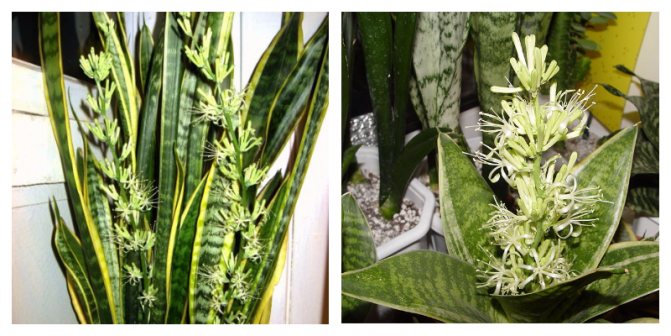

Signs associated with Sansevieria
- A huge web of beliefs and superstitions is woven around the ‘’ Mother-in-law tongue ’. Believe them or not - individually for everyone. It is interesting that many signs contradict the natural characteristics of the plant itself.
- Unexpected flowering promises the beginning of a new stage in life, well-being and harmony in the house. Along with this, winter flowers are considered a big negative. What if the biological clock of the succulent is set to blossom during the frost season?
- The ‘‘ tongues ’‘ ’growing upward attract all the negative energy, providing a cozy and warm atmosphere of the living space.
- The blame for troubles is always the desire to throw on someone other than yourself. The window pet here is the best option - no answer. Here is just a statement: a flower - a healer is unlikely to harm.
Mother-in-law's tongue: what kind of plant is it and is it possible to keep it at home
Baba Nina's help - just ask your question and get an answer
Under the name Mother-in-law's tongue, there is an unpretentious sansevieria plant. People call him:
- Snake skin;
- Pike tail;
- Indian sword;
- Devil's tongue;
- Leopard lily.
Most often you can hear about him that you cannot keep him at home. This superstition is associated with the appearance of the plant, in which the leaves are crowned with a sharp tip and look menacing. In fact, this is a common myth. If you want to install a negative energy absorber at home, then the mother-in-law's tongue flower is perfect for this. Can you keep it at home? Of course, yes - it will serve as a lightning rod from quarrels and scandals. But before buying or receiving a sprout, you should study all its magical properties.



